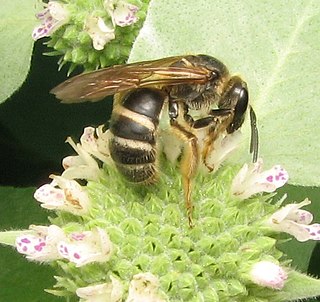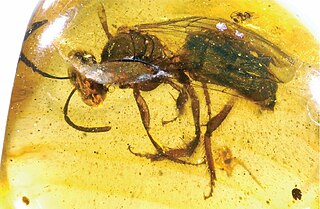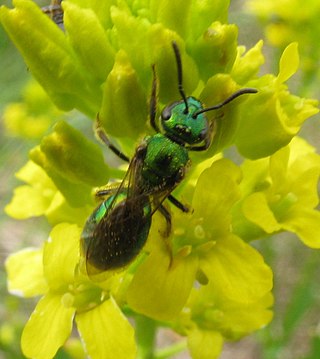
Bees are winged insects closely related to wasps and ants, known for their roles in pollination and, in the case of the best-known bee species, the western honey bee, for producing honey. Bees are a monophyletic lineage within the superfamily Apoidea. They are currently considered a clade, called Anthophila. There are over 20,000 known species of bees in seven recognized biological families. Some species – including honey bees, bumblebees, and stingless bees – live socially in colonies while most species (>90%) – including mason bees, carpenter bees, leafcutter bees, and sweat bees – are solitary.

Halictidae is the second-largest family of bees with nearly 4,500 species. They are commonly called sweat bees, as they are often attracted to perspiration. Halictid species are an extremely diverse group that can vary greatly in appearance. These bees occur all over the world and are found on every continent except Antarctica. Usually dark-colored and often metallic, halictids are found in various sizes, colors and patterns. Several species are all or partly green and a few are red, purple, or blue. A number of them have yellow markings, especially the males, which commonly have yellow faces, a pattern widespread among the various families of bees. The family is one of many with short tongues and is best distinguished by the arcuate basal vein found on the wing. Females in this family tend to be larger than the males. They are the group for which the term 'eusocial' was first coined by entomologist, Suzanne Batra.
Michael S. Engel, FLS, FRES is an American paleontologist and entomologist, notable for contributions to insect evolutionary biology and classification. In connection with his studies he has undertaken field expeditions in Central Asia, Asia Minor, the Levant, Arabia, eastern Africa, the high Arctic, and South and North America, and has published more than 925 papers in scientific journals.Some of Engel's research images were included in exhibitions on the aesthetic value of scientific imagery.

The sweat bee genus Lasioglossum is the largest of all bee genera, containing over 1800 species in numerous subgenera worldwide. They are highly variable in size, coloration, and sculpture; among the more unusual variants, some are cleptoparasites, some are nocturnal, and some are oligolectic. Most Lasioglossum species nest in the ground, but some nest in rotten logs.
Neocorynura electra is an extinct species of sweat bee in the Halictidae genus Neocorynura.

Oligochlora is an extinct genus of sweat bee in the Halictidae subfamily Halictinae. The genus currently contains six species, all of which are known from the early Miocene Burdigalian stage Dominican amber deposits on the island of Hispaniola.

Nesagapostemon is an extinct monotypic genus of sweat bee in the Halictidae subfamily Halictinae. At present, it contains the single species Nesagapostemon moronei.
Eickwortapis is an extinct monotypic genus of sweat bee in the Halictidae subfamily Halictinae which contains the single species Eickwortapis dominicana.
Augochlora leptoloba is a species of sweat bee in the genus Augochlora and the extinct monotypic subgenus Electraugochlora.
Protosialis casca is an extinct species of alderfly in the Sialidae subfamily Sialinae. The species is solely known from the early Miocene, Burdigalian stage, Dominican amber deposits on the island of Hispaniola. Protosialis casca is one of only two known alderfly species present in the West Indies, the only other species is the living Protosialis bifasciata native to Cuba.
Halictus? savenyei is an extinct species of sweat bee possibly in the halictid genus Halictus. The species is solely known from the Early Eocene, Ypresian stage, Coldwater Beds, part of the Princeton Group, in the Quilchena area, Nicola Country, British Columbia, Canada.
Ischnomelissa rasmusseni is a Neotropic bee in the family Halictidae.

Nomia is a genus of sweat bees in the family Halictidae. Many species have opalescent bands on the metasoma. Nomia species are moderate-sized bees that nest in the ground. Most species nest solitarily, but some species also nest communally where females share a nest but where there are no queen or worker castes. Nomia species are found Africa, tropical Asia, Australia, and in North America. There are about 130 species world wide.

Sphecodes is a genus of cuckoo bees from the family Halictidae, the majority of which are black and red in colour and are colloquially known as blood bees. Sphecodes bees are kleptoparasitic on other bees, especially bees in the genera Lasioglossum, Halictus and Andrena. The adults consume nectar, but because they use other bees' provisions to feed their offspring they do not collect pollen.

Augochlorini is a tribe of sweat bees in the subfamily Halictinae. They are found in the Nearctic and Neotropic realms. They typically display metallic coloration, with many species that are red, gold, green, blue, or purple.

Augochlorella is a genus in the bee family Halictidae, commonly called sweat bees. They display metallic coloration, ranging from reddish to gold to bluish green, as is typical for other genera in the tribe Augochlorini.

Megalopta is a widespread neotropical genus of bees in the tribe Augochlorini in family Halictidae, known as the sweat bees. They are the largest of the five nocturnal genera in Augochlorini. Most have pale integumentary pigmentation, and all have large ocelli, most likely a feature of their nocturnal behavior. They live in tropical Central America and the entirety of South America. The subgenus Noctoraptor is cleptoparasitic. They are not known from the fossil record.
Chlerogas is a genus of bees belonging to the family Halictidae.
Megaloptidia is a genus of bees belonging to the family Halictidae.
Megommation is a genus of bees belonging to the family Halictidae.









